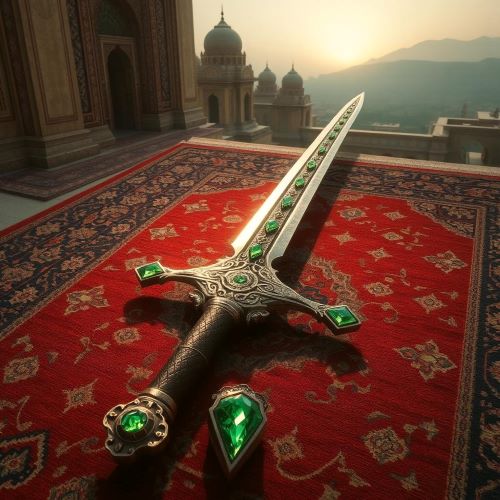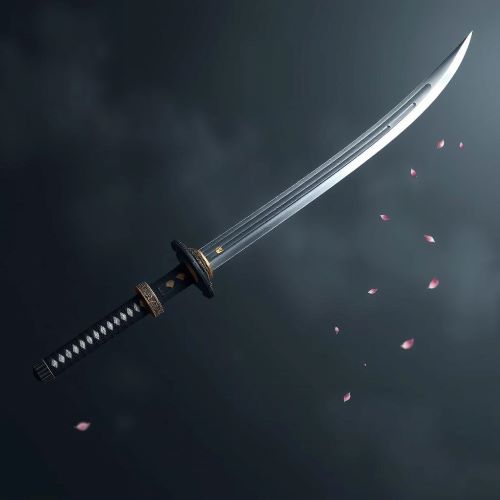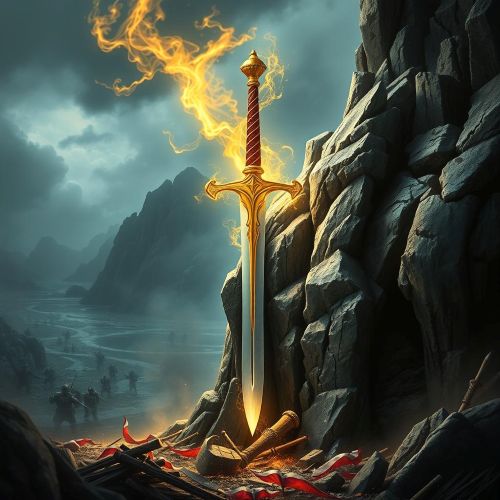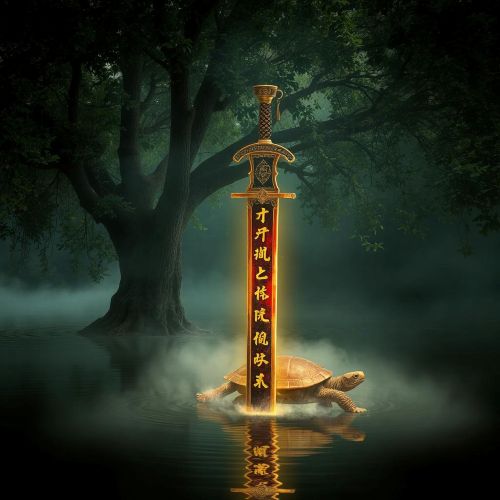Skofnung : The Spirit Sword
Skofnung
Introduction
Skofnung is one of the most fabled swords in Norse mythology, often celebrated for its unmatched sharpness and enigmatic magical qualities. Unlike divine weapons wielded by gods, Skofnung belonged to human warriors and kings, particularly King Hrólf Kraki. This legendary blade is said to carry the spirits of twelve berserker warriors, imbuing it with supernatural power. Over time, it has become more than just a weapon—it is a symbol of divine craftsmanship, shrouded in lore, superstition, and heroism. The stories surrounding Skofnung extend far beyond its original battlefield use, turning it into a legendary artifact that continues to captivate scholars, storytellers, and gamers alike.
Origins
The sword’s story begins with Hrólf Kraki, a king remembered in Scandinavian legend as both a noble ruler and fierce warrior. After his death, Skofnung was buried with him in a burial mound near Roskilde. Centuries later, an Icelandic warrior named Skeggi of Midfirth unearthed it during a grave robbery, discovering the blade in remarkably pristine condition thanks to the dryness of the sealed chamber. This act of reclaiming weapons from burial mounds was not unusual in Norse lore and often served to bridge the gap between myth and potential history. The sagas that recount Skeggi’s retrieval of Skofnung suggest that such artifacts carried historical weight as well as symbolic meaning. Its appearance in different sagas over generations indicates that it had a lasting impact on Nordic oral tradition and literature.
Think you know your myths and legends? Dive into the world of ancient stories and test your knowledge with our engaging quizzes on Mythlok!
Powers
Skofnung’s mystique lies not just in its origin but in its extraordinary powers. Known for its unparalleled sharpness and unbreakable strength, the blade inflicted wounds that were resistant to healing. The only known remedy for such injuries was the use of the Skofnung Stone, a mystical artifact paired with the sword. Additionally, the sword housed the spirits of twelve berserker warriors, lending it an eerie sentience and enhanced fighting ability. Legends warn that the sword must not be drawn in the presence of women, nor should sunlight fall upon its hilt. Ignoring these warnings could cause the weapon to resist being unsheathed, or even emit a terrifying howl. In some accounts, a spectral snake would retreat into the hilt when the sword was disrespected, indicating the sword’s active rejection of improper use. Rituals such as breathing on the blade before drawing it were said to activate its spiritual force.
Owners/Users
Skofnung passed through the hands of several notable figures after its recovery from Hrólf Kraki’s grave. Skeggi of Midfirth was its first posthumous wielder, though he initially hesitated to loan it out due to its powerful reputation. Eventually, he lent it to the poet-warrior Kormac at the request of Kormac’s mother, but only with strict instructions. Kormac’s mishandling of the sword during a duel—disregarding its magical rules—led to the weapon reacting violently, refusing to cooperate. Skeggi later passed the sword to his son, Eid of Ás, who intended to use it for vengeance. The blade then went to Thorkel Eyjólfsson, a kinsman of Eid, who never returned it. Thorkel carried Skofnung until his untimely death in a shipwreck, after which the sword was recovered and taken up by his son Gellir Thorkelsson. Gellir eventually died during a pilgrimage to Rome, and it’s believed that Skofnung was buried with him in Denmark, its final resting place lost to history.
Instances used
Skofnung’s presence is recorded across several classic Icelandic sagas, underscoring its mythological significance. In Hrólfs saga kraka, it is hailed as the greatest sword ever wielded in the northern lands, with attributes that go far beyond mortal craftsmanship. Kormáks saga explores the sword’s peculiar magical restrictions and illustrates the consequences of mishandling it, particularly when Kormac tries to draw the blade without following the necessary rituals. In Laxdæla saga, the sword’s movement from one owner to another is chronicled, showing the continuity of its mythic legacy through different generations. These texts don’t just describe Skofnung as a weapon, but as a living artifact with agency, demands, and consequences for those who cross its boundaries.
Its story doesn’t end with the old texts. Skofnung has found a new life in modern adaptations and pop culture. It appears as a recurring magical item in the Final Fantasy game series, showcasing its iconic status in fantasy literature and entertainment. In Rick Riordan’s mythological universe, Skofnung is wielded to perform magical acts, including freeing the Norse god Loki. In the God of War game series, the blade is featured as the soul-infused sword of Hrólf Kraki, further cementing its place in modern myth-inspired media. These appearances illustrate how Skofnung has transformed from a saga relic to a cultural artifact with continuing relevance.
Frequently Asked Questions
Lorem ipsum dolor sit amet, consectetur adipiscing?
Lorem ipsum dolor sit amet, consectetur adipiscing elit. Praesent convallis vestibulum justo, ac tincidunt nunc vehicula quis. Nullam id dolor quis orci malesuada feugiat. Curabitur aliquet libero at urna ullamcorper, ac ultricies nulla dapibus.
Lorem ipsum dolor sit amet, consectetur adipiscing?
Lorem ipsum dolor sit amet, consectetur adipiscing elit. Praesent convallis vestibulum justo, ac tincidunt nunc vehicula quis. Nullam id dolor quis orci malesuada feugiat. Curabitur aliquet libero at urna ullamcorper, ac ultricies nulla dapibus.
Lorem ipsum dolor sit amet, consectetur adipiscing?
Lorem ipsum dolor sit amet, consectetur adipiscing elit. Praesent convallis vestibulum justo, ac tincidunt nunc vehicula quis. Nullam id dolor quis orci malesuada feugiat. Curabitur aliquet libero at urna ullamcorper, ac ultricies nulla dapibus.
Lorem ipsum dolor sit amet, consectetur adipiscing?
Lorem ipsum dolor sit amet, consectetur adipiscing elit. Praesent convallis vestibulum justo, ac tincidunt nunc vehicula quis. Nullam id dolor quis orci malesuada feugiat. Curabitur aliquet libero at urna ullamcorper, ac ultricies nulla dapibus.
Lorem ipsum dolor sit amet, consectetur adipiscing?
Lorem ipsum dolor sit amet, consectetur adipiscing elit. Praesent convallis vestibulum justo, ac tincidunt nunc vehicula quis. Nullam id dolor quis orci malesuada feugiat. Curabitur aliquet libero at urna ullamcorper, ac ultricies nulla dapibus.
Watch
Source
Byock, J. L. (1995). The Saga of King Hrolf Kraki. University of California Press.
Faulkes, A. (2011). Eddic Poetry and Sagas of Icelanders: A Literary Connection. Saga-Book, 35.
Orchard, A. (1997). Dictionary of Norse Myth and Legend. Cassell.
Pálsson, H., & Magnusson, M. (1970). Laxdæla Saga. Penguin Classics.
Kuro Zyboniacchi. (2015). Skofnung – Wikipedia, The Free Encyclopedia | PDF | Sword – Scribd. https://www.scribd.com/document/317316748/Skofnung-Wikipedia-The-Free-Encyclopedia
Evie Roebuck. (2021). The Deadliest Weapons In Norse Mythology | Author Evie Roebuck. https://www.sociomix.com/c/entertainment/the-deadliest-weapons-in-norse-mythology/1629573295
Skofnung | Mythosjourney. (2025). https://www.mythosjourney.com/encyclopedia/pages/skofnung/index.html









